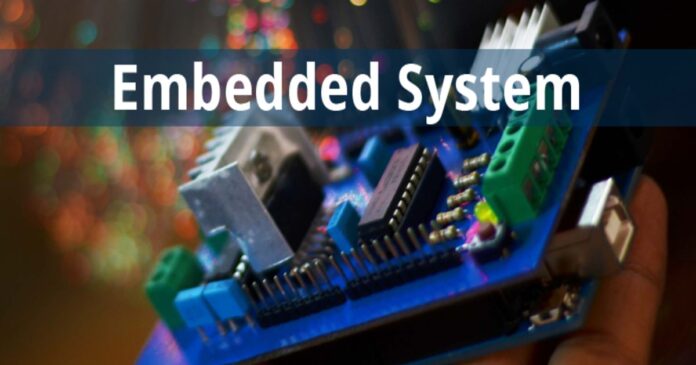
Nowadays, we don’t often think about how, let’s say, smartwatches work. It calculates our steps, tracks how we sleep, and so on. However, only 20 years ago, such an ordinary device could be a piece of miracle. Moreover, similar devices were considered to be science-fiction. Still, everyone wanted to have one in the future. So, let’s figure out how such a tiny gadget works and what it has in common with the embedded hardware?
What Is An Embedded System?
The embedded system refers to a bundle of hardware and software set together to perform a particular task. Besides, one bundle may exist within another one. Thus, it can be either programmable or work only for a specific task. Almost every modern electronic device may be considered an embedded system.
The main responsibility of a microprocessor-based system is computing. That is why it doesn’t need to have a User Interface (UI) that is user-friendly. Quite often, they do not have it at all since they constantly compute only one task.
Back to the smartwatch, it is right to consider it as an embedded system with hardware (the body and the processor inside it) and the operational system. And this is only one example among thousands. According to MarketsandMarkets research, the embedded system’s potential earnings may reach 166 billion USD by 2025. The increase of interest in special hardware is caused by the popularity of AI and investments in related projects that require high-performance processors.
What Are The Common Examples Of Embedded Hardware?
As it was already mentioned, the embedded systems are not only limited by a smartwatch. The hardware, along with special software, is applied in the majority of industries. Here are the most common ones:
Mobile phones have one microprocessor-based complex and a number of functions such as camera, input, and output modules, etc.
Cars are often stuffed with the majority of electronic equipment, including the embedded systems that have their own tasks. For instance, there is a rain sensor, cruise control, parking sensors, etc.
Modern machinery also can include embedded hardware or can be an embedded system itself. Machinery is an excellent example of performing a specific task like controlling or monitoring the current quality.

What Does An Embedded System Usually Consist Of?
Depending on the purpose and the industry where the microprocessor-based system is implemented, some of its elements may be excluded or added. However, the core elements are usually present.
Software is a program that performs a specific task, so its complexity varies. However, the most straightforward machinery usually is operated by the simplest OS.
The real-time operating system is not common. However, it plays the role of supervisor of software performance by correcting the rules for it when necessary.
Hardware is represented by microprocessors that compute the data and microcontrollers that control the whole complex. Meanwhile, there may also be some sensors, processors, actuators, etc.

What Types Of Embedded Systems Do Exist?
It’s pretty difficult to mention all the types, but they can be divided into a few categories. Consequently, each of them has a few types. So here they are:
1. By functional requirements
- A standalone system performs a single specific task. An excellent example is an MP3 player.
- The mobile one refers to portability and small size. The digital camera is an excellent, bright example of such a system.
- A networked one is able to connect to other systems. The cashier machine is one of those.
- A real-time one is programmed to provide an output in a particular time gap.
2. By performance
- Small-scale ones are usually equipped with an 8-bit microcontroller only
- Medium-scale are usually equipped with 16-32 bit microcontroller that may be linked together
- Complex-scale ones usually use more than one algorithm, which requires upgraded hardware, so more complex software
3. By architecture type
- Simple control loops architecture is able to call subroutines that are responsible for a specific part of the hardware
- Interrupt controlled systems are designed to trigger tasks once there appear interruptions in the loops. By the way, there may be main and secondary loops.
- Non-preemptive multitasking refers to the operating system that never triggers a context switch from one to another process.
- Preemptive multitasking refers to the operating system that is responsible for switching from one process to another but analyzing the current criteria.
How An Embedded System Function?
The embedded system is just a part of a device, so it is responsible for the proper functioning of a particular element in this device. The great advantage of it is their easiness of maintenance and relatively low cost. Besides, they consume very little energy dedicated to a whole device.
As mentioned, the basic composition is a processor and special software, but it can also involve a battery, memory card, and communication ports. The latter ones provide issue-free data transmitting to peripheral devices that are also usually embedded systems. That’s where the software and memory come into play: the software stored on the memory card processes the data. That’s it!
The embedded systems are often used in IoT solutions, too. As you might have known, this is the best way to improve overall efficiency. However, producing such equipment without any specific expertise is quite a challenging task. Besides, it will take way much more time than it is expected. If you intend and are looking for a trusted partner who can provide a ready solution according to your preferences, you should contact Axonim. This company has enough expertise and a proven track record that won’t make you bothered by such delicate things but focusing only on business-related tasks.










